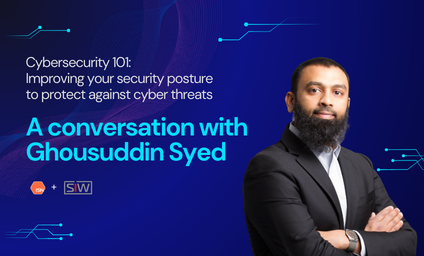Cybersecurity is a vital aspect of any business, especially in today’s digital world. With the increasing frequency and sophistication of cyberattacks, businesses need to protect their data, systems, and reputation from potential threats.

Recently, SecurityInfoWatch.com interviewed Ghousuddin Syed, the Vice President of Technology and Infrastructure at ISN. Syed shared his insights on the current state of cybersecurity, the challenges and opportunities for ISN, and the best practices for businesses to enhance their cybersecurity posture.
The Current State of Cybersecurity
Syed described the current state of cybersecurity as “dynamic and evolving”. He said that cyberattacks are becoming more frequent, complex, and targeted, affecting businesses of all sizes and industries. He also said that cybersecurity is not only a technical issue, but also a business and human issue, requiring collaboration and awareness from all stakeholders.
“Cybersecurity is not just an IT problem. It is a business problem and a human problem. It requires a holistic approach that involves people, processes, and technology. It also requires constant vigilance and adaptation to the changing threat landscape.”
Some of the current trends and challenges in cybersecurity that Syed mentioned are:
- The rise of ransomware attacks, which encrypt the victim’s data and demand a ransom for its release
- The shift to remote work, which increases the attack surface and exposes vulnerabilities in the network and devices
- The proliferation of cloud services, which offer scalability and flexibility, but also introduce new risks and complexities
- The shortage of cybersecurity talent, which creates a gap between the demand and supply of skilled professionals
The Challenges and Opportunities for ISN
As a company that handles sensitive data from thousands of clients and contractors, ISN faces unique challenges and opportunities in cybersecurity. Syed explained how ISN manages its cybersecurity strategy and operations, and how it leverages its strengths and capabilities to address the challenges and opportunities.
“At ISN, we have a robust cybersecurity program that aligns with our business objectives and customer expectations. We follow the ISO 27001 standard, which is the international best practice for information security management. We also have a dedicated product security team that ensures the security of our software development lifecycle and our products. We conduct regular security audits, assessments, and tests to identify and mitigate any risks or issues.”
Some of the challenges and opportunities that Syed highlighted are:
- The need to balance security and usability, which requires a user-centric design and a risk-based approach
- The need to comply with various regulations and standards, which requires a comprehensive and consistent framework
- The need to educate and empower the users, which requires a culture of security and a proactive communication
- The opportunity to innovate and differentiate, which requires a continuous improvement and a customer-focused mindset
The Best Practices for Businesses
Syed also shared some of the best practices and tips for businesses to improve their cybersecurity posture and resilience. He emphasized the importance of having a clear and actionable cybersecurity plan, a strong and diverse cybersecurity team, and an effective cybersecurity awareness training program.
“Cybersecurity is not a one-time project. It is a continuous process that requires planning, execution, monitoring, and improvement. It is also not a one-person job. It is a team effort that requires collaboration, diversity, and inclusion. And it is not a static skill. It is a dynamic skill that requires learning, updating, and practicing.”
Some of the best practices and tips that Syed suggested are:
- Define your cybersecurity goals and metrics, and align them with your business goals and metrics
- Build a cybersecurity team that has the right skills, experience, and perspectives, and foster a culture of security and accountability
- Provide regular and effective cybersecurity training to your employees, contractors, and suppliers, and test their knowledge and behavior
- Implement the basic cybersecurity hygiene, such as using strong passwords, updating software, backing up data, and encrypting communications
- Use the available tools and resources, such as antivirus software, firewalls, VPNs, and security frameworks, to protect your systems and data
- Stay informed and aware of the latest cybersecurity trends, threats, and best practices, and adjust your cybersecurity plan and actions accordingly
Cybersecurity is a crucial and challenging aspect of any business, especially in today’s digital world. Click here to read Syed's full article with SecurityInfoWatch.